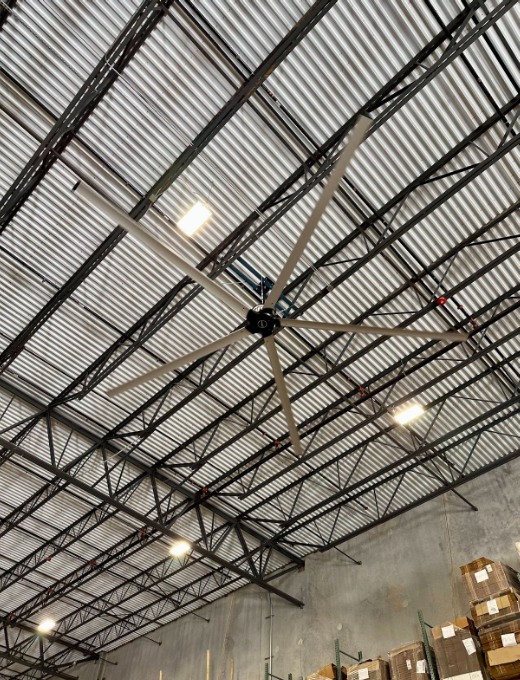
With the present global awareness about environmental issues, business owners are looking for ways to reduce their carbon footprint in order to implement green business practices. HVLS (High-Volume, Low-Speed) fans is one remedy that is gradually making its way into practice. When it comes to ventilation and airflow, HVLS fans have become somewhat of a celebrity. These fans, which were first intended for use in massive industrial settings, have been modified for a variety of general uses, including residential, commercial, and agricultural.
Here, we’ll look at the positive impact of HVLS fans on the energy usage, greenhouse gas emissions, and general sustainability of commercial and industrial establishments.
Lower Energy Consumption
The impact of HVLS fans in lowering the energy costs of HVAC systems is also key to sustainability and energy efficiency. These tremendous fans are mounted on ceilings to generate a steady, round-the-clock circulation that taps heat currents from the floor levels and the upper levels by merely recirculating air.
This mild air movement improves the distribution of conditioned air throughout the room, which makes HVAC systems operate much more efficiently. The perceived temperature can be lowered by up to 10 degrees Fahrenheit in the summer using HVLS fans, enabling thermostats to be set higher without sacrificing comfort. This modification has the potential to result in a 30% decrease in energy usage, which will reduce greenhouse gas emissions and leave a reduced carbon footprint.
In the winter, HVLS fans can be reversed to run at moderate speeds, gently moving warm air stored in the ceiling back down to the floor. By lowering the demand for heating systems and assisting in the maintenance of a constant interior temperature, this procedure—known as destratification—further promotes energy efficiency and environmental sustainability.
Reduced Emission of Greenhouse Gases
Reduced greenhouse gas emissions are a direct and quantifiable result of the lower energy consumption made possible by HVLS fans, and they also lessen environmental pollution and climate change. Since fossil fuels like coal and natural gas still account for the majority of the world’s electrical production, every unit of energy saved through efficiency measures averts harmful emissions.
In particular, 0. 95 pounds of CO2 are released for every kWh of power generated in the US, as reported by the EPA. That means that if a factory installs HVLS fans and saves 1,000,000 kWh a year, then about 500 metric tons of CO2 emissions are kept out of the atmosphere.
When compared to other costly measures of energy conservation, such as putting in place solar panels or heating, ventilating, and air conditioning systems, HVLS actually remain very inexpensive in conserving the environment and minimizing the carbon imprint of an organization.
Economical Sustainability
HVLS fans provide major financial benefits in addition to environmental ones, increasing the affordability and accessibility of sustainability for building owners and enterprises. Long-term savings on energy bills and maintenance expenses can more than outweigh the initial cost of HVLS fans. Because of their sturdy structure and straightforward design, HVLS fans require less maintenance than traditional HVAC systems, which are more prone to wear and tear and require frequent repair.
Moreover, HVLS fans’ dependability and longevity lessen the need for frequent replacements, which minimizes waste and the environmental effect of producing and discarding quickly depreciating equipment. This component of sustainability encourages the use of durable, energy-efficient technology, thereby extending the lifecycle of building infrastructure and supporting a circular economy.
Green Building Initiatives
Installing HVLS fans can earn businesses and building owners important credits and points toward green building certifications like LEED (Leadership in Energy and Environmental Design).
Energy-efficient and sustainable mechanical systems earn points under the U.S. Green Building Council’s LEED standards. By ensuring HVAC energy savings via destratification and air movement, HVLS fans can earn these marks.
Using HVLS fans is an easy and tried-and-true method to gain credits toward LEED certification, even though the precise number of points provided can differ depending on the project’s specifics and the particular LEED rating system being utilized.
Conclusion
HVLS fans endorse the triple bottom line. The idea of the “triple bottom line” pushes companies to think about their social and environmental effects in addition to financial gains. HVLS enthusiasts wholeheartedly concur with these ideas:
- Economical: HVLS fans are a wise financial choice because of their ability to save energy and quickly pay for themselves.
- Environmental: As previously mentioned, HVLS fans lessen waste, carbon emissions, and environmental stress.
- Social: Employees work in more pleasant, effective, and secure environments when there is better air circulation.
Businesses that invest in HVLS fans aren’t just “going green” but rather optimizing their operations in a way that benefits the earth, people, and profits equally. It is a long-lasting enhancement that fulfills every requirement.
Refresh Fans is your partner in attaining maximum comfort and sustainability through energy-efficient, inventive ventilation systems. Choose us for modern HVLS fan solutions and help us in creating a greener future.